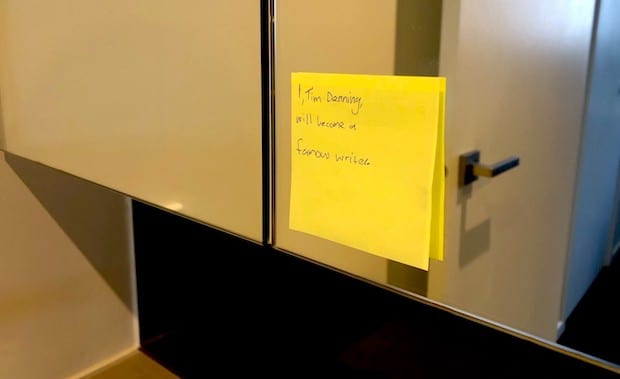Success Advice
Why I Broke Up With You Twitter And Have Found Someone Else

Dear Twitter, when we fell in love in March 2009, you were the cutest and the best bird I had ever met. I remember when we used to sit in bed together during those long, cold, winter nights. Now I just feel like I don’t know you anymore.
You never let me speak my mind with your 140-character limit, and you have become overweight with too many part time users. I don’t feel like you talk to me enough by sharing what I tweet on you, and you hardly share me with your friends like you used to.
Other, much cuter birds, have taken my attention away from you like Instagram with her sexy filtered pictures, flawless skin, and luscious colors. I started cheating on you with Instagram and then I found myself hooking up with her friends Snapchat and Periscope.
To my surprise, I even find myself starting to look again at older more mature birds like Facebook because of the way you make me feel. You haven’t aged as gracefully as others with your ever increasing wrinkles, and your inner beauty just doesn’t shine through like the bird I once knew.
Every time I tell you that you need a makeover, you just ignore me with your short bites of content and your robotic auto replies. So Twitter, I can’t do this anymore. I am breaking up with you. I’ll miss you Twitter but the time has come for me to see other people. Tim.
Below are the eight reasons why I broke up with Twitter:
1. Automated posts
One of the challenges Twitter is having is that social media is making a move towards real-time. I’m not saying that Twitter is the only platform that has automated posts, but it’s one of the worst offenders.
There are so many Twitter accounts that have more than three tweets a day, and you just know that they were scheduled a long way in advance. Many of these same tweets are often rehashed content from the user’s account that has been posted before on Twitter.
Tweets just feel too spammy these days and like a robot is writing them, and then repeating them over and over. It’s this reason more than any other that I believe Twitter is dying a slow death. Their financial position at times seems to reflect the same sentiment.
2. Followers are meaningless
Twitter, more than any other social platform, has the ability to add followers, which I now believe, are virtually meaningless. There are so many automated follower software tools that you can use to fake the number of followers you really have.
It’s not about the number of followers you have; I believe it’s about the amount of engagement you have with your followers that is the real power.
3. Useless automated replies
Not only are followers meaningless, but when you connect with someone new Twitter allows users to have spammy auto replies. These automated replies usually have some form of self-promotion or link to a product that someone wants you to buy.
This whole function just feels outdated and adds to the argument that Twitter is not relevant anymore and is dying a slow death.
4. Not enough characters
Fundamentally, one of the restrictions of Twitter is the number of characters you can type. In the beginning, it was cool, but over time, it has just become annoying because you can’t say anything of any substance.
This is why tweets are not memorable, which in turn, makes a lot of what the platform does forgettable. Maybe I am wrong on this one, but I get this feedback from people on social media all the time.
5. Engagement is at an all time low
I am lucky enough to be connected with quite a few mega influencers who have followers in the hundreds of thousands. I don’t tell you this to brag; I mention it because it allows me to ask the successful people on Twitter their thoughts of the current state of play.
Every single one of them says that their engagement with their fans on Twitter is at an all time low, and they just don’t get the same level of retweets and favoured tweets as they use too.
Many are moving to other social media outlets or automating their accounts entirely so they can concentrate on other platforms.
6. Too much spam
As I have highlighted in the previous points, and I want to highlight again, Twitter just has too much spam nowadays. Many of the posts are not about adding value but are more focused towards shameless self-promotion.
It seems like Twitter has become the one platform that has ignored Gary Vaynerchuk’s advice from his book Jab, Jab, Jab, Right Hook. For those who haven’t read it, it’s a simple concept; deliver three tweets of value (the jabs) and then one tweet (the right hook) with an ask such as “subscribe to my mailing list.”
7. Uninspiring interface
Over time Twitters, interface hasn’t changed a lot. Beginners still find the Twitter concept hard to understand, and the interface is nothing too exciting, What Twitter needs in its interface is some cool new features.
Without any updates, I fear that Twitter will continue to go the same way as the Apple iPhone. It will continue to lose its relevance and what made it an awesome platform in the first place.
8. Too many hashtags
Hashtags are a great way to find content on social media. Another reason why I believe Twitter is dying a slow death is that hashtags have become overused on the platform. When you write one sentence and have three or more hashtags all promoting a brand or product, it just doesn’t feel right.
***Final Thought***
To be clear, this post is really my personal opinion of Twitter, and I’d like to think I have some credibility around its use. The purpose of this post is not to hate on Twitter but to point out some improvements so that maybe the masses will lobby for change.
While I think Twitter is dying there are still some great social media platforms that will achieve some similar results. An example of one is LinkedIn, which has gone from a site about people’s resumes, to a real, multifaceted social media platform.
I feel that LinkedIn engagement is at an all-time high, and the “Influencer Pages” are what Twitter should have done. Even though Twitter is becoming less attractive, I still find that following super-human influencers with millions of followers – like Tony Robbins and Richard Branson – is 100% worth my time.
Are you going to break up with Twitter? What’s your current favourite social media platform and why? Let me know in the comments section below or on my website timdenning.net and my Facebook.
Success Advice
Betify Casino: Guide Détaillé 257
Les enjeux de responsabilité sociale prennent une importance croissante dans le secteur, et Betify Casino s’inscrit dans cette évolution. Cette analyse numéro 257 examine les caractéristiques structurantes de cette plateforme dans un contexte compétitif exigeant.
L’accès via https://www.restaurantcru.fr/ dévoile une interface conçue pour concilier accessibilité et profondeur fonctionnelle. Les outils de prévention et d’accompagnement deviennent des différenciateurs compétitifs, et cette préoccupation se manifeste dès les premières interactions avec la plateforme.
La promotion d’un jeu maîtrisé et raisonnable s’impose comme standard éthique. Notre évaluation repose sur des critères objectifs : richesse du catalogue, efficacité du support, sécurité des transactions, et conformité réglementaire. Chaque dimension fait l’objet d’un examen méthodique.
Cryptomonnaies
Les virements bancaires traditionnels restent privilégiés pour les montants importants malgré des délais plus étendus. Cette méthode autorise le transfert de sommes conséquentes (99720€ et au-delà) en une seule opération, idéale pour les high-rollers souhaitant rapatrier des gains substantiels directement vers leur compte bancaire principal.
La procédure KYC (Know Your Customer) reste incontournable avant le premier retrait. Les documents requis comprennent : pièce d’identité en cours de validité (carte nationale, passeport, permis de conduire), justificatif de domicile récent (facture, avis d’imposition, attestation), et parfois justificatif de la méthode de paiement (relevé bancaire, capture de carte avec numéros partiellement masqués).
La conformité aux standards industriels et aux réglementations en vigueur fait l’objet d’une vigilance constante. Les audits réguliers et les certifications obtenues attestent du respect scrupuleux des obligations légales et des bonnes pratiques sectorielles. Cette rigueur réglementaire renforce la crédibilité de l’opérateur sur un marché où la confiance constitue un facteur différenciant majeur.
Casino en Direct
La compatibilité technique assure une expérience fluide sur l’ensemble de l’écosystème matériel moderne. Les jeux développés en HTML5 s’exécutent nativement dans les navigateurs web sans nécessiter de plugins additionnels. Cette approche garantit la portabilité entre ordinateurs de bureau, laptops, tablettes, et smartphones, indépendamment du système d’exploitation (Windows, macOS, iOS, Android, Linux).
Les taux de redistribution théoriques (RTP) varient selon les titres, avec une fourchette globale s’étendant de 95% à 98%. La médiane se situe autour de 98%, reflétant les standards contemporains du secteur. Ces informations sont accessibles dans les règles de chaque jeu, permettant aux utilisateurs de faire des choix éclairés selon leur appétence au risque.
L’équilibre entre accessibilité immédiate et richesse fonctionnelle constitue un défi permanent pour toute plateforme de cette envergure. Les solutions déployées témoignent d’une réflexion approfondie sur l’ergonomie et l’expérience utilisateur, visant à minimiser la courbe d’apprentissage tout en offrant des possibilités avancées aux utilisateurs expérimentés.
Cashback
Les bonus sans dépôt, distribués occasionnellement, permettent de tester la plateforme sans risque financier initial. Ces offres incluent typiquement 26 à 43 tours gratuits ou un petit crédit de 20€. Les conditions de mise appliquées sont généralement plus élevées (64x à 54x) et les plafonds de retrait plus restrictifs (180€ maximum).
La transparence des conditions promotionnelles évite les malentendus frustrants. Chaque offre dispose d’une page détaillée spécifiant : jeux éligibles, période de validité, exigences de mise, contributions par catégorie, montants minimaux et maximaux, ainsi que toute restriction géographique ou liée au statut du compte. Cette clarté renforce la confiance.
Les restrictions durant les périodes bonus visent à prévenir les abus stratégiques. Les mises sont généralement plafonnées à 5€ par tour ou main tant que les conditions de rollover restent insatisfaites. Le dépassement de cette limite peut entraîner l’annulation du bonus actif et des gains générés sous son égide.
Les investissements réalisés dans l’infrastructure technique sous-jacente garantissent des performances optimales même en période de forte affluence. La scalabilité de l’architecture permet d’absorber les pics de trafic sans dégradation perceptible de l’expérience utilisateur. Cette robustesse technique constitue un prérequis indispensable pour maintenir un niveau de satisfaction élevé.
FAQ
Un système d’escalade hiérarchique garantit qu’aucune situation ne reste sans réponse appropriée. Les demandes non résolues au premier niveau remontent automatiquement vers des superviseurs expérimentés disposant d’habilitations élargies. Les cas exceptionnels peuvent être portés jusqu’à la direction si nécessaire.
Les comptes VIP de niveau supérieur bénéficient parfois d’une ligne téléphonique directe ou d’un gestionnaire personnel dédié. Ce service premium garantit un traitement prioritaire et une relation individualisée pour les joueurs générant un volume d’activité conséquent, avec numéro direct et disponibilité élargie.
Les temps de résolution varient selon la complexité. Les problèmes simples (réinitialisation de mot de passe, déblocage de compte temporaire) trouvent solution en quelques minutes. Les cas nécessitant investigation (litige sur transaction, réclamation concernant un jeu) peuvent requérir 92 à 36 jours avec communication régulière sur le statut d’avancement.
Les investissements réalisés dans l’infrastructure technique sous-jacente garantissent des performances optimales même en période de forte affluence. La scalabilité de l’architecture permet d’absorber les pics de trafic sans dégradation perceptible de l’expérience utilisateur. Cette robustesse technique constitue un prérequis indispensable pour maintenir un niveau de satisfaction élevé.
Licence
L’authentification à deux facteurs (2FA) optionnelle sécurise l’accès au compte. Après activation, chaque connexion depuis un terminal non reconnu nécessite un code temporaire à usage unique envoyé par SMS ou généré par application d’authentification (Google Authenticator, Authy, Microsoft Authenticator).
Les systèmes de détection et prévention d’intrusion (IDS/IPS) surveillent en temps réel les flux réseau. Les patterns anormaux déclenchent des alertes automatiques et des mesures de mitigation. Les attaques DDoS sont absorbées par des infrastructures de filtrage distribuées avant d’atteindre les serveurs applicatifs.
La documentation technique et les ressources d’aide mises à disposition facilitent grandement l’autonomie des utilisateurs. Des tutoriels détaillés aux FAQ exhaustives, l’ensemble des points de questionnement potentiels est anticipé et traité. Cette stratégie de documentation proactive réduit significativement la charge pesant sur les équipes de support.
Support 24/7
L’assistance par email convient aux demandes complexes nécessitant annexes ou investigation approfondie. Les délais de première réponse oscillent entre 17h et 40h pour les requêtes standard, avec possibilité de priorisation pour les cas urgents. Un système de ticketing numéroté assure traçabilité et suivi de l’avancement.
La qualité du support fait l’objet d’évaluations régulières via enquêtes de satisfaction post-résolution. Ces retours alimentent la formation continue et l’identification d’axes d’amélioration. Un scoring interne mesure les performances individuelles sur rapidité, pertinence des réponses, courtoisie, et taux de résolution au premier contact.
Programme VIP
Les exigences de mise (wagering requirements) imposent de jouer le montant du bonus 50x avant de pouvoir retirer les gains associés. Cette condition doit être satisfaite dans un délai de 32 jours calendaires suivant l’activation. Les contributions par type de jeu diffèrent : 100% pour les machines à sous, 8% pour les jeux de table, et souvent 0% pour le live dealer.
Les plafonds de gains retirables issus de promotions gratuites protègent l’opérateur contre les jackpots fortuits. Ces limites oscillent typiquement entre 96€ et 367€ pour les bonus sans dépôt, tandis que les offres liées à un versement réel affichent des plafonds plus généreux voire inexistants pour les niveaux VIP supérieurs.
La transparence des conditions promotionnelles évite les malentendus frustrants. Chaque offre dispose d’une page détaillée spécifiant : jeux éligibles, période de validité, exigences de mise, contributions par catégorie, montants minimaux et maximaux, ainsi que toute restriction géographique ou liée au statut du compte. Cette clarté renforce la confiance.
Jeu Responsable
Les partenariats avec organismes spécialisés assurent l’accès à une aide professionnelle. Joueurs Info Service (09 74 75 13 13), SOS Joueurs (09 69 39 55 12), et Addict’Aide (0 800 23 13 13) offrent écoute anonyme et gratuite, conseil, et orientation vers thérapeutes spécialisés en addictologie comportementale.
L’exclusion définitive permet de fermer irréversiblement un compte sur simple demande écrite. Cette démarche radicale s’adresse aux personnes reconnaissant un problème de jeu et souhaitant couper définitivement tout lien avec la plateforme. L’identité est inscrite dans des registres inter-opérateurs prévenant les réinscriptions sur sites affiliés.
Cette caractéristique spécifique mérite une attention particulière dans le contexte global de l’offre. Les choix techniques et stratégiques effectués reflètent une vision à long terme qui privilégie la durabilité et l’évolutivité de la plateforme. Cette approche garantit une capacité d’adaptation aux évolutions futures du marché et des attentes utilisateurs.
Bilan
Cette investigation approfondie numéro 257 révèle une offre s’inscrivant dans les standards contemporains du secteur. Les dimensions analysées reflètent une ambition de répondre aux attentes d’utilisateurs aux profils variés.
Les forces identifiées comprennent la cohérence de l’expérience entre différents supports, la richesse des mécanismes promotionnels, et le respect des obligations réglementaires. Les opportunités d’amélioration dépendent des priorités personnelles de chaque utilisateur.
Le lecteur dispose désormais d’éléments substantiels pour évaluer la pertinence de cette proposition. L’objectivité de l’approche vise à faciliter l’auto-évaluation sans orienter artificiellement les décisions individuelles.
Success Advice
Évaluation de Betify Casino #86
La compétition stimule l’innovation permanente. C’est dans ce contexte que Betify Casino développe son offre, cherchant à se démarquer par des choix spécifiques. Cette évaluation numéro 86 explore ces particularités et leur pertinence pour les utilisateurs potentiels.
Dès la consultation de https://www.vertical-tair-parachutisme.fr/, certains partis pris deviennent apparents : design épuré, organisation logique des contenus, mise en avant des promotions actives. L’industrie du jeu en ligne atteint une maturité nouvelle, et cela se traduit par une expérience utilisateur travaillée dès le premier contact.
Les standards de qualité s’élèvent progressivement. Notre investigation couvre l’ensemble du spectre fonctionnel : inscription et vérification, méthodes bancaires, catalogue ludique, mécanismes promotionnels, support client, et outils de jeu responsable. Cette approche holistique permet une compréhension complète de la proposition de valeur.
Application Mobile
La navigation tactile est repensée pour une utilisation au pouce avec des zones cliquables dimensionnées généreusement (53px minimum), évitant les clics accidentels. Les menus déroulants, accordéons, et swipes horizontaux remplacent les survols souris impossibles sur écran tactile. L’ergonomie mobile est réellement native, pas un simple portage.
La rotation de l’écran est gérée intelligemment avec des interfaces adaptées aux modes portrait et paysage. Certains jeux privilégient l’orientation horizontale pour un rendu optimal (machines à sous panoramiques, jeux de table), tandis que d’autres s’accommodent parfaitement du mode vertical facilitant l’utilisation d’une seule main.
Les jeux en live sont parfaitement fonctionnels sur mobile avec des streams vidéo en définition adaptative ajustant automatiquement la qualité selon la bande passante disponible. Les contrôles de mise et boutons d’action sont réorganisés pour ne pas obstruer la vue de la table, préservant l’immersion même sur écrans réduits.
La conformité aux standards industriels et aux réglementations en vigueur fait l’objet d’une vigilance constante. Les audits réguliers et les certifications obtenues attestent du respect scrupuleux des obligations légales et des bonnes pratiques sectorielles. Cette rigueur réglementaire renforce la crédibilité de l’opérateur sur un marché où la confiance constitue un facteur différenciant majeur.
La conformité aux standards industriels et aux réglementations en vigueur fait l’objet d’une vigilance constante. Les audits réguliers et les certifications obtenues attestent du respect scrupuleux des obligations légales et des bonnes pratiques sectorielles. Cette rigueur réglementaire renforce la crédibilité de l’opérateur sur un marché où la confiance constitue un facteur différenciant majeur.
Retraits Rapides
Les portefeuilles électroniques permettent de centraliser plusieurs sources de financement et offrent une couche d’abstraction protégeant les coordonnées bancaires. Les transactions via Skrill, Neteller, ou MuchBetter ne nécessitent que l’adresse email associée au compte e-wallet, simplifiant le processus tout en renforçant la confidentialité.
Les délais de traitement des dépôts sont quasi-instantanés pour les méthodes électroniques, créditant le compte joueur en moins de 2 minutes. Les montants minimaux démarrent à 12€ rendant la plateforme accessible aux petits budgets, tandis que les plafonds atteignent 5018€ par transaction pour les comptes standards.
Les limites de retrait mensuel varient significativement selon le statut du compte. Les utilisateurs standard peuvent retirer jusqu’à 13535€ par mois, tandis que les niveaux VIP supérieurs bénéficient de plafonds progressivement relevés pouvant atteindre 68545€ voire illimités pour les statuts les plus élevés.
La conformité aux standards industriels et aux réglementations en vigueur fait l’objet d’une vigilance constante. Les audits réguliers et les certifications obtenues attestent du respect scrupuleux des obligations légales et des bonnes pratiques sectorielles. Cette rigueur réglementaire renforce la crédibilité de l’opérateur sur un marché où la confiance constitue un facteur différenciant majeur.
Les retours d’expérience collectés auprès des utilisateurs actifs alimentent un processus d’amélioration continue. Cette démarche itérative permet d’identifier rapidement les points de friction potentiels et d’y apporter des réponses adaptées. La réactivité dans le traitement de ces retours constitue un indicateur clé de la maturité opérationnelle.
Catalogue de Jeux
La compatibilité technique des jeux est assurée sur l’ensemble des terminaux modernes. Les titres en HTML5 s’exécutent nativement dans les navigateurs sans plugin additionnel, garantissant une expérience fluide sur ordinateurs de bureau, laptops, tablettes, et smartphones de différentes marques.
Les modes de démonstration gratuits disponibles sur la majorité des jeux permettent de tester les mécaniques et le gameplay sans engager de fonds réels. Cette possibilité facilite la découverte et aide les joueurs à identifier les titres correspondant à leurs préférences avant de parier en argent réel.
La conformité aux standards industriels et aux réglementations en vigueur fait l’objet d’une vigilance constante. Les audits réguliers et les certifications obtenues attestent du respect scrupuleux des obligations légales et des bonnes pratiques sectorielles. Cette rigueur réglementaire renforce la crédibilité de l’opérateur sur un marché où la confiance constitue un facteur différenciant majeur.
Jeux de Table
La compatibilité technique des jeux est assurée sur l’ensemble des terminaux modernes. Les titres en HTML5 s’exécutent nativement dans les navigateurs sans plugin additionnel, garantissant une expérience fluide sur ordinateurs de bureau, laptops, tablettes, et smartphones de différentes marques.
Les taux de redistribution théoriques (RTP) affichés pour chaque jeu informent les joueurs des probabilités mathématiques. La fourchette observée s’étend généralement de 94% à 97%, avec une médiane autour de 96% reflétant les standards actuels du secteur.
Plateforme Mobile
L’intégralité des fonctionnalités desktop est disponible en mobilité : consultation du compte, historique des transactions, activation de bonus, gestion des limites de jeu, contact du support via chat ou email. Seules quelques opérations administratives complexes peuvent occasionnellement nécessiter un accès depuis ordinateur.
La sécurité mobile bénéficie des mêmes standards que la version desktop : cryptage TLS, authentification multifactorielle optionnelle, déconnexion automatique après inactivité. Des fonctionnalités biométriques (Touch ID, Face ID sur iOS, empreinte digitale sur Android) peuvent être activées pour sécuriser l’accès à l’application mobile si une app dédiée existe.
La documentation technique et les ressources d’aide mises à disposition facilitent grandement l’autonomie des utilisateurs. Des tutoriels détaillés aux FAQ exhaustives, l’ensemble des points de questionnement potentiels est anticipé et traité. Cette stratégie de documentation proactive réduit significativement la charge pesant sur les équipes de support.
Dépôts Instantanés
Les virements bancaires traditionnels restent privilégiés pour les montants importants malgré des délais plus longs. Cette méthode permet de transférer des sommes conséquentes (10981€ et au-delà) en une seule opération, idéale pour les high-rollers ou les joueurs souhaitant rapatrier des gains substantiels sur leur compte bancaire principal.
La procédure de vérification d’identité (Know Your Customer) est obligatoire avant le premier retrait. Les documents requis incluent une copie d’une pièce d’identité officielle en cours de validité, un justificatif de domicile récent (moins de 3 mois), et parfois une capture de la méthode de paiement utilisée (carte bancaire recto avec certains chiffres masqués).
Les investissements réalisés dans l’infrastructure technique sous-jacente garantissent des performances optimales même en période de forte affluence. La scalabilité de l’architecture permet d’absorber les pics de trafic sans dégradation perceptible de l’expérience utilisateur. Cette robustesse technique constitue un prérequis indispensable pour maintenir un niveau de satisfaction élevé.
Les investissements réalisés dans l’infrastructure technique sous-jacente garantissent des performances optimales même en période de forte affluence. La scalabilité de l’architecture permet d’absorber les pics de trafic sans dégradation perceptible de l’expérience utilisateur. Cette robustesse technique constitue un prérequis indispensable pour maintenir un niveau de satisfaction élevé.
La documentation technique et les ressources d’aide mises à disposition facilitent grandement l’autonomie des utilisateurs. Des tutoriels détaillés aux FAQ exhaustives, l’ensemble des points de questionnement potentiels est anticipé et traité. Cette stratégie de documentation proactive réduit significativement la charge pesant sur les équipes de support.
Jeu Responsable
Les partenariats avec des organismes spécialisés assurent l’accès à une aide professionnelle : Addict Aide (0 800 23 13 13). Ces lignes d’écoute anonymes et gratuites offrent soutien, conseil, et orientation vers des thérapeutes spécialisés en addictologie comportementale.
La protection des mineurs est assurée par des systèmes de vérification d’âge obligatoires dès l’inscription. Aucun compte ne peut être activé sans fourniture d’une pièce d’identité validant la majorité légale (18 ans selon la juridiction). Toute tentative de contournement entraîne un bannissement permanent et un signalement aux autorités si nécessaire.
Cette caractéristique spécifique mérite une attention particulière dans le contexte global de l’offre. Les choix techniques et stratégiques effectués reflètent une vision à long terme qui privilégie la durabilité et l’évolutivité de la plateforme. Cette approche garantit une capacité d’adaptation aux évolutions futures du marché et des attentes utilisateurs.
Bilan
Cette exploration approfondie numéro 86 révèle une proposition s’inscrivant dans les standards contemporains du secteur. Les différentes dimensions analysées témoignent d’une volonté de répondre aux attentes d’un public diversifié.
Les forces identifiées incluent la cohérence de l’expérience sur différents supports, la richesse des mécanismes promotionnels, et le respect des obligations réglementaires. Les opportunités d’amélioration varient selon les priorités personnelles de chaque utilisateur.
Le lecteur dispose désormais d’éléments substantiels pour évaluer la pertinence de cette offre. L’objectivité de l’approche vise à faciliter l’auto-évaluation sans orienter artificiellement la décision individuelle.
Success Advice
6 Finest Oral Intercourse Positions With Illustrations And Tips Lynk Pleasure Sexual Health Podcast For Males
I know it might really feel like a punishment however I promise it’s not! Ask your partner how they really feel when one or both of you’re on your phone, laptop, iPad, or other screens. Intimacy, to bust one other fantasy, is more than just getting laid or figuring out the best positions. It’s about being open, trustworthy, susceptible, and real and allowing another person to be the identical with you. According to woman naked the National Health Service within the United Kingdom, a long-term research of nuns reported that many lived nicely into their 90s and previous one hundred years old. Having an orgasm will increase blood circulate and releases natural pain-relieving chemical substances.
Finest Sex Positions For Female Orgasm (with Illustrations And Tips)
Fashion and sociology experts say that, when inspecting the significance of any bold style statement, context plays an essential role. The internet erupted into discourse in regards to the second, with some brushing it off as traditional Kanye antics and others outraged on the show. “If I do them back-to-back, it’s nearly like a pc rebooting,” she stated.
- It’s essential to evaluate and replace your policies and procedures following any incidents, to make sure they include any new information realized and present finest apply.
- Controversial but thought to be one of the most intense lesbian love sagas ever made, ‘Blue is the Warmest Color’ is the narrative of Adele and Emma, two teenagers who fall for one another.
- They can even make a referral to a intercourse therapist or different therapist for counseling.
- Her movie ‘Female Perversions’ is the narrative of Eve, an lawyer in LA, who has an unsatisfactory sex life and seeks respite from the erotic nightmares she has on a day by day basis.
Sensations could range from discomfort to extreme pleasure, so give consideration to what feels good for each companions whereas you’re discovering oral sex. Keep in mind that every particular person’s anatomy, scent, and taste are different, and so is what they discover pleasurable. If you feel uncomfortable at any point, don’t be afraid to stop or change what you are doing, or to ask your companion to do so. Good sexual health locations a excessive precedence on healthy relationships, deliberate pregnancies, and prevention of sexually transmitted infections. Sometimes the answer to higher sex is in your drugs chest. Some medicine, such as antidepressants and blood strain medicines, can reduce your desire.
She additionally encourages her shoppers to experiment with totally different toys. Drug store chains typically carry lubricant, and a lot of stock a few toys as properly. She says these sorts of norms discourage dialogue of wholesome sexuality for older of us, which can maintain them again when they might must adapt their method in mattress. But in case you are, know that sex is good in your mental and bodily well being.
Release Date
If you fall into the latter group, stress from wherever in your life — your job, a parent’s sickness, an unexpected invoice — may be getting in the way in which. Be type and give your self permission to grieve what was lost and mirror on what that relationship taught you. Journal your uncensored thoughts, talk it out with a therapist, or (my old favorite) write a letter to your ex that you simply will not ship. Sex would possibly mean different things to different people, but what ultimately matters is how you’re feeling in regards to the encounter and that you’re defending your self. There’s no Official Book of Sex Rules that particulars exactly what share of a penis must be inserted to guarantee that it to rely as “Real Sex.” It’s nonetheless thought of sex, or an try at sex.
Survey takes a detailed take a glance at evolving patterns in sexual frequency, preferences, and the use of contraception. Exposure to cosmic radiation and weightlessness in space might increase the chance of astronauts developing erectile dysfunction, based on research in rats. A fantastic opportunity for AASECT Members to deepen your engagement and connect with like-minded members throughout the year. Let’s discover a few of the advantages that having intercourse can give you. Whenever you’re having a very good hair or ass day, take commemorative photographs, then put them in a non-public folder for future use.
What this means is that, as an alternative of looking for and add issues that turn you on, it is easier to take away issues that flip you off. For example, if a messy house will stress you out, you may be extra engaged and eager to participate if the house is clean, quite than if you’ve come home to rose petals on the mattress in a messy house. Making small changes by removing things that you do not like can vastly improve your intercourse life.
In the joy stage, the body prepares for sexual activity by tensing muscular tissues and rising heart fee. In the male, blood flows into the penis, causing it to turn into erect; in the feminine, the vaginal walls become moist, the internal part of the vagina becomes wider, and the clitoris enlarges. In the plateau stage, respiratory becomes extra fast and the muscle tissue continue to tense.
You might get an infection in your mouth or throat from giving a blowjob to somebody with a genital or anal an infection. And when you have an STI in your mouth or throat, you can unfold it to your associate’s penis. Some infections, such as mpox, are additionally spread via skin-to-skin contact.
Then, take what you study from masturbation and communicate what you discover with your partner. Your companion will be higher at pleasing you should you can inform them what you want. Sex refers to biology; nonetheless, there is not a single, universally agreed-upon set of pointers for defining intercourse. Sex is advanced, dynamic, context-dependent, and interacts with gender and different social factors (Ritz & Greaves, 2022; Dubois et al., 2025). There are a wide variety of available contraception choices. Some methods require a prescription or a minor process in the doctor’s office, and a few don’t.
A SUNY Oswego Alum, she graduated with a degree in Broadcasting and Mass Communication and a minor in Gender Studies, and whereas there acquired several awards for her three speak exhibits and work in native news. Her favourite pastimes include watching Dr. Phil, working towards her Emmy acceptance speech, and subtly sneaking feminism into her day by day conversations. Although police forces in Northern Ireland and Scotland are not ready to make use of Outcome 21, they are prone to keep away from prosecuting children unless it is in the public interest. Your referral will be danger assessed, and motion taken to protect the kid as applicable; either by way of statutory involvement or different help. All staff and volunteers must be familiar with these paperwork and understand tips on how to follow them. It’s good follow to make them obtainable to oldsters and young folks – you might need to consider creating a teenager friendly version.
Success Advice
Best Interac Casinos Canada 2025 e-Transfer Casino Sites
Best Interac Casinos Canada 2025 e-Transfer Casino Sites
Premium Interac casinos offer 24/7 payment processing, reducing wait times for night-time withdrawal requests. Existing players are included as there’s a juicy loyalty program. Also, eligible players have a 100% match bonus on the first four deposits. This predominantly varies depending on the casino you’re playing with. The sites we recommend on this page offer reliable assurance that your money and details are secure. This is standard for all casinos and if this is not required, it should be a red flag.
Interac Online Casino Withdrawals
Interac uses the same banking system, which means you can get the same level of security. If they do, we immediately go to the banking section and look for the Interac banking logo. That’s worthy of note because the banking limits for these options might differ. Interac is generally a great way to pay when it comes to casinos. Only those Interac casinos that focus on good customer service make the cut.
What we don’t like about Playzilla:
The first deposit is matched up to $400, and the second and third are matched up to $300. One of the most appealing features on the site is the welcome bonus. Each deposit earns you a match deposit bonus that can earn you up to $1500. We’re also big fans of the VIP program that rewards existing players for their loyalty. The whole process of making the gambling deposit in one of your favorite Interac online casinos will take about ten minutes. If you are looking for a native Canadian solution for the casino deposit, here is a perfect option.
List of Casinos in Ontario
We recommend using any of the online casinos we mentioned in the sections above. Since these are top banks which are standing behind Interac it is a completely safe online payment service. As you will see from our review if you choose Interac payment can be made in a safe and convenient way. One can use this https://www.scoobynet.com/group.php?&do=discuss&groupid=89&discussionid=1328 banking method in some of the best online casinos in Canada to make deposits as well as to withdraw money. Instadebit is also a popular payment method at Interac casinos Canada.
Set a Gambling Budget
.png)
We are lucky as Canadians to have the choice to gamble, whether it is with online casinos in Canada or land based ones. We here at Casino Canuck have been gambling long before online casinos even existed. Most casino sites require a minimum deposit of $10, while some accept as low as $5. Bank transfers are widely available at real money gambling sites.
Top Games Available At Interac Online Casinos
See if the online casino has optimised its games and interface for Android and iOS users. After a successful debut in 2025, Fast Slots Casino has become a favourite among Canadian players. Operating with a Curaçao licence, the brand is subject to strict regulatory oversight, which ensures fair gameplay and secure payments for players. Our Del Oro review provides in-depth insight into the casino site to help you understand the platform. Use Interac to set clear bankroll boundaries — treating transfers as a single session budget can help avoid chasing losses.
The games these providers offer are safe and loaded with cutting-edge graphics, innovative gameplay and deep mechanics. If Interac payments are not protected properly, the review stops there. Canadian casinos need from 24 to 72 hours to verify your withdrawal request. Check its promotions page, and bonus terms and conditions, to see if such a feature is available. Firstly, if you make a minimum deposit, some games may not be available to you simply because of the minimum bet size limits. As soon as Interac casinos Canada process the request, they pass it to Interac.
Online gambling is legal when operated by provincial governments or through licensed operators. In Ontario, for example, casinos must be licensed by AGCO and operate under iGaming Ontario. Always choose casinos with verifiable licensing for the best protection and safety.
-

 Did You Know4 weeks ago
Did You Know4 weeks agoThe Success Patterns You Inherited (And Didn’t Notice)
-

 Entrepreneurs3 weeks ago
Entrepreneurs3 weeks agoThe Essential Skills Every Entrepreneur Needs In 2026
-

 Business4 weeks ago
Business4 weeks agoThe Hidden Money Pit in Your Operations (and How to Use It)
-

 Change Your Mindset3 weeks ago
Change Your Mindset3 weeks agoHow to Turn Your Mind Into Your Greatest Asset (Instead of Your Enemy)
-

 Change Your Mindset3 weeks ago
Change Your Mindset3 weeks agoThe Silent Skill That Makes People Respect You Instantly
-

 Life2 weeks ago
Life2 weeks ago10 Research-Backed Steps to Create Real Change This New Year
-

 Tech2 weeks ago
Tech2 weeks agoWhat’s in a Name? How to Get Your Domain Right
-

 Did You Know1 week ago
Did You Know1 week agoHow Skilled Migrants Are Building Successful Careers After Moving Countries



















12 Comments